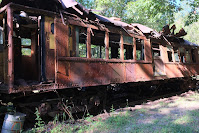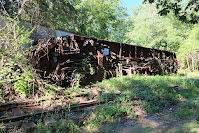Someone who wishes to remain anonymous has submitted some photos taken a week ago at the Connecticut Trolley Museum during that organization's "Everything That Moves" event. Many thanks for these submissions, as they have made possible some notable updates to the PNAERC list.
First, here's
Bristol Traction 34, an unusual single-truck semi-convertible built by Wason in 1917. It's a body that has long sat alongside the CTM shop and at this point it seems that it has started to collapse. I'm leaving it on the PNAERC list for now, but with a note about its condition.
Here's a sad one:
Chicago Elevated Railway 4284, a standard Chicago "4000" built in 1922 and acquired by CTM in 1975. In the late 1970s this car was repainted in as-built colors and some backdating work (notably the door sash) was done, but I believe its interior was left taken apart so it was never put into service.
A 1979 photo can be found here. It's been deteriorating for years. This car is still part of the CTM collection and was not part of the recent
deaccession and sale.
Corbin E2 is a four-wheel battery locomotive built in 1907 by Baldwin-Westinghouse. I have no idea whether it ever ran at CTM, but if it did, then it was quite a few years ago.
In the top photo, Corbin E2 is on the left and in the center is
Massachusetts Bay Transit Authority 3003, the oldest extant Boston PCC car and one of five PCC's from that city at CTM. This car was built by Pullman-Standard in 1941 and acquired by CTM back in 1977. Part of its interior was restored by volunteers (you can see some fairly nice-looking ceiling panels in that second shot) but then the car was put outside and it went downhill rapidly.
is Dallas double-ended PCC, built by Pullman-Standard in 1945 as Dallas Railway & Terminal 625. It was sold to Boston in 1959 and went to CTM in 1978. Amazingly, this car actually ran as recently as about 2006, and I believe it's the most recent Dallas double-ended PCC anywhere to move under its own power.
I'll confess I'm not certain which is which, but these two are
MBTA 3306 and
3309, both "picture window" PCC cars built for Boston by Pullman-Standard in 1951. I think this was the only series of PCC streetcar to be built for U.S. service with MCM control. These cars have both been at CTM since 1992 and I do not know whether either has ever run at the museum.
This is
Montreal Tramways W1, a generally typical derrick work car. It was built by Industrial Brownhoist in 1910 and served until the end, going to CTM in 1959. Its cab has long sat outside the museum's shop building.
And now we get to the cars that were deaccessed in 2018. This is
Chicago Transit Authority 4175, one of four surviving (perhaps "surviving" should be in quotation marks) center-entrance "Baldy" type 4000s. The car was built by Cincinnati in 1915, put into work service as work motor S360 in 1965, and retired in 1979. At that point it was briefly shipped out to the Illinois Railway Museum, where its motors were removed because CTM wanted a Baldy trailer and not a Baldy motor (the earlies "Baldies" were trailers but this one was built, and always ran as, a motor car). It then went out to Connecticut. I'm honestly not sure whether to leave it on the PNAERC list. I don't know why its steel roof is torn open like that, and it appears that part of the car side has been pushed in. This doesn't look like the car just started collapsing; it looks more like CTM has started scrapping it. Either way, it doesn't look very salvageable.
North Shore 162 is one of the two interurban cars from that line that were deaccessed by CTM in 2018 and is by far the better of the two in terms of condition. That said, its condition is deteriorating rapidly and it already looks a lot like car 710 did a decade or so ago. I'm not sure what the museum's plans are for this car right now, nor whether it has been purchased - either as a complete car or for parts - by any other group.
And here's the other North Shore car. This is car 710, built by Cincinnati in 1924. Like car 162, it went to the ill-fated American Museum of Electricity project in Niskayuna, NY after the North Shore quit in 1963 and then ended up going to CTM in 1971. Neither North Shore car ever ran in Connecticut and car 710's condition had gotten particularly bad in recent years. It now appears that CTM is in the process of scrapping the car; it's obviously been tipped off its trucks and it looks like underbody equipment is being salvaged for reuse, which is good. I have removed this car from the PNAERC roster. It is the fourth North Shore car, and first 700-series car, scrapped during the preservation era.

I cannot say with absolute certainty but I'm pretty sure that this pile of scrap metal is all that remains of Chicago Transit Authority 4409, the other 4000-series car (beside 4175 pictured above) that was deaccessed in 2018. Car 4409 was a standard, generally unremarkable 4000-series car built by Cincinnati in 1924 and acquired by CTM in 1979. Car 4409 has been removed from the PNAERC list. (That said, if I'm wrong about the identity of the subject of this photo, please let me know!
I've been wrong about this kind of thing before.)
It's tough to see electric cars getting scrapped like this, but
as I wrote when the museum announced the deaccession of these pieces, it makes sense to get rid of them. None of the deaccessed cars is unique in preservation and all are likely beyond CTM's means to restore at this point. Other, more historic cars at the museum, like
AE&C 303, are
suffering grievously for want of money and resources, and CTM is doing the right thing to pare down its collection so that it can focus a bit more on maintaining the other cars in its fleet. It appears that parts are being stripped off of these cars to facilitate the restoration of cars at other museums, and at this point that's probably the highest and best use for these pieces.
EDIT: I've also changed the status of two other cars at CTM.
York Utilities 72, a Birney built in 1919 for Laconia Street Railway, and
Manchester Street Railway 94, a single-truck Wason dating to 1905, are both streetcars bodies that are currently listed on CTM's
website roster. However I never saw them when I visited the museum a few times 10-15 years ago and I believe the reason is that their locations had been swallowed by the forest and made them largely inaccessible except during the winter. Regardless, I've changed these two from "stored inoperable" to "situation unknown" because I have doubts they are still intact. Any clarification on their status is appreciated.

















